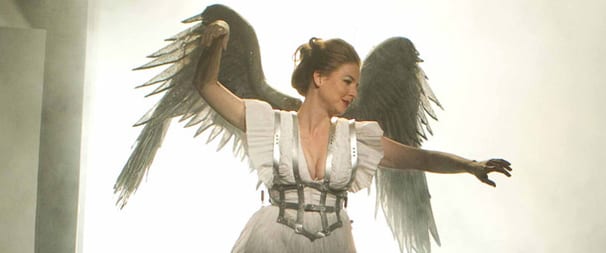Pre-Module Research and Musings
This was asked to be researched on the lead up to the first session as the class will primarily discuss the role and reason for a Dramaturg, simply put, ‘What is Dramaturgy?’ and ‘Have you ever done any dramaturgy before and how?’
This was paired with a play that has made the biggest impact on you.
Reflections of the role of a Dramaturg or what Dramaturgy means to me.
From a very quick and early standpoint, the role of dramaturg seems very similar to that of a collaborator. The difference seems to lie in eloquence and academic panache.
Bozic speaks of a generator and a ‘red line’ which runs through the work. This seems very akin to the devised procedure of storytelling in theatre, with a stimulus acting as a springboard of ideas and concepts, to the ‘through line’ which holds the story together whilst simultaneously moving the it on.

Isn’t She Lovely – Stevie Wonder
The second point Bozic makes on the dramaturg references their use in engaging multiple sources across numerous mediums to create a melting pot of creativity with a means to use this product within the installation or performance in mind. Again, this just seems like academic posturing, generating a educational void between the collaborative relationships already in place between writers, performers, collaborators, directors, producers, stage managers and the audience. This can be seen in the merging of producer and creative collaborator in Nick Sweeting, working with Improbable Theatre.
Bozic feels like she is complicating a relatively simplistic approach to imagining devised performative aspects of theatre or installations in a way which not only complicates this process but undermines the creative rank of other predestined roles within devising a performance.
Her third point on the role of a dramaturg started to bug me on a simply grammatical standpoint. So I looked away from this article and started reading from Cathy Turner and Synne K. Behrndt’s Dramaturgy and Performance which, eloquently in its opening statement states “In many respects, this is an impossible book to write.” (p1, 2008) Bold words, considering the impressive 228 pages that follows. Within this introduction, they introduce us to dramaturg as a verb, how perplexing. So this is a substance within a play or performance, a role and now a doing word.
Sigur 3 – Sigur Ros
Also mentioned is the reasoning for the UK rise of the dramaturg as this has been a widely used concept, role and verb in mainland europe for quite some time. This makes sense, buoying the creative portion of new writing to help dwindling numbers in the 1990’s. But with new writing very much alive a quarter of a century later, is the role not only falling out of context but out of need? The drop of new writing was primarily a by-product of cuts made by the Thatcher led Tory government. Could we see a resurgence in the need for the dramaturg with deep cuts affecting the arts yet again?
Turner and Behrndt go on to discuss the complicated approach to the rise that came about with the role of the dramaturg. With Kushner’s Angels in America and Mamet’s Oleanna leading the way in the US: Churchill and Hare producing fine work in the UK. This was seen as a result more of the writer in terms of their talent, subject matter and self-help provided more than that of the emergence of the dramaturg.

I have moved on to the first chapter and read a rather frustratingly, unnecessary, almost politican-esque approach to the question ‘What is a dramaturg’ in Kerkhoven’s Theaterschrift:
“It appeared … that dramaturgy involves everything, is to be found in everything, and is hard to pin down. Is it only possible to think of dramaturgy in terms of spoken theatre, or is there a dramaturgy for movement, sound, light and so on, as well? Is dramaturgy the thing that connects all the various elements of a play together?” (p8, 1994)
We live in a world where subsidised theatre reigns. Where shoe-string productions tour the country.I understand the need to blend roles in order to cut production costs. I more than understand, I realise its necessity in regards to keeping regional theatre afloat. So why would another role need to exist which kind of does some of the elements of a number of roles but is not involved in the physical creation of the performance, play or installation. It seems to a layman to the ‘role’, as I would consider myself, a surplus position, designed to fulfil the succinct creative nuance of a collaborator who keenly wishes to finger all the pies (if dramaturg is to be neologized, I will do so with finger) without shouldering the burden necessary for the genesis of creative work. In answer to your previous question, Kerkhoven, “Is dramaturgy the thing that connects all the various elements of a play together?” the word you seem to be searching for seems to be that of the director or producer.
I believe I have ‘dramaturged’ out of an economic necessity, not an ideological or academic one.
Play(s) With Impact
This included with a play that has affected me the most. I will most likely be using Weepie by Chris Goode from a performance standpoint and Angels in America by Tony Kushner for the play that has affected me from a writer/storytelling standpoint.
Chris Goode’s unpublished Weepie, as a performer opened up avenues that I had not been privvy to up until this point. Depth of character understanding, the storytelling role of the actor and the physical, emotional and mental connections an actor can make with a character and it’s reflective qualities.
Angels in America in terms of the size of performance can take.
Lungs, simplicity but density of text.
Works Cited
Turner,Cathy and Behrndt, Synne K, Dramaturgy and Performance, 2008
Kerkhoven, Marianne van, Theaterschrift, 1994, Brussels: Kaaitheater